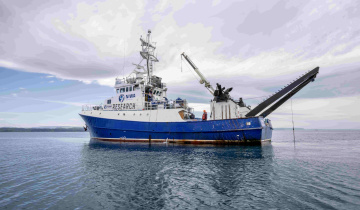Scientists returned to the Nukumea Stream in Orewa last week, to investigate the trial release of giant kōkopu. This is the first controlled trial in New Zealand to test whether the native fish, giant kōkopu, can be successfully stocked into a stream.
Last week NIWA scientists carried out electric fishing and night time spotlight surveys, in the stream; capturing and measuring the fish and recording the locations that they were found in.
In December 2009, NIWA implanted thirty giant kōkopu with tiny transponder tags (PIT tags) and released them in the Nukumea Stream. Each tag has a unique ID, so that when the tagged fish pass by the antennae positioned in the stream, they can be identified. By tagging the fish the scientists are able to monitor how well they survive, and where they choose to live.
"The first follow up survey, using handheld PIT tag readers, was carried out in January. “We knew that some of the fish had left the study reach as they had been detected on our antennae, but we managed to locate 15 (out of 30) of the giant kōkopu, which was a pleasing result,” says NIWA Freshwater Fish Scientist, Dr Paul Franklin.
“Unfortunately, the recent follow-up survey failed to locate any of the giant kōkopu that were released into the Nukumea Stream in December, and had been found during previous follow-up surveys in January and February,” says Dr Franklin.
"It was expected that many of the giant kōkopu would eventually leave the pilot study reach, but it was hoped that a few would remain. It is thought that extremely low water levels in the river, caused by the recent lack of rain, may have restricted the amount of habitat available for the fish and contributed to the giant kōkopu no longer being present."
Many of the banded kōkopu, a different species of whitebait, that had been captured in the stream and marked during a previous baseline survey carried out in October, were still resident in the pilot study reach. This means that they were not displaced or out-competed by the giant kōkopu whilst they were in the reach and it also suggests that these fish may be more resilient to the low flow conditions within the stream.
NIWA will continue monitoring over the next few months as water levels increase again so that we can see if any of the giant kōkopu return to the reach, and to see how well the banded kōkopu continue to do.
Adult giant kōkopu breed in fresh water. Their larvae drift out to sea, and then return to rivers and streams as one of the species that make up ‘whitebait’. A major cause of their decline has been loss of habitat.
Scientists also think that the adult fish produce a chemical signal or ‘pheromone’ to tell whitebait which streams to return to.
Unfortunately, it is too early yet for the scientists to tell whether this pheromone production has occurred in the Nukumea Stream. The scientists will have a better idea next whitebait season.
The fish are monitored by NIWA and a team led by Dave Slaven, Ecology Team Leader Northern Gateway Alliance (NGA). The fish used for the trial were hatched and reared in tanks at Mahurangi Technical Institute from eggs originally collected from the Waitetuna River.
The NZ Transport Agency and its NGA partners undertook this project as part of the mitigation programme associated with the recent construction of the NZTA’s Northern Gateway Toll Road on SH1.
If the trial is successful, the NZTA and its NGA partners plan to release 500 –1000 juvenile giant kōkopu into the stream at a future date to augment the declining population.








